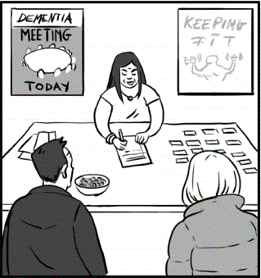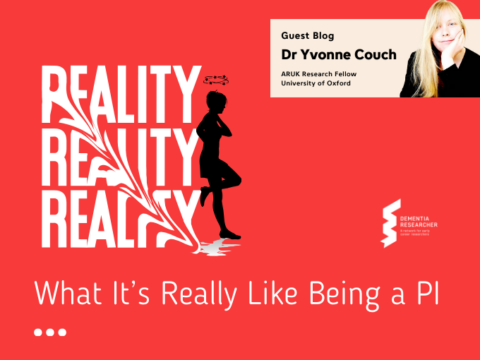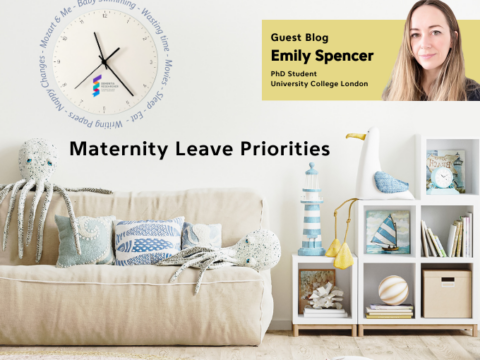 Three years ago, I moved from Belgium where I was born, to the UK to live with my (UK native) girlfriend in Hebden Bridge. It was through her I met Dr. Campbell. She had seen some of my work on Instagram and thought I would be a good fit to bring the stories of the Neighbourhoods: Our People, Our Places participants to life. In Belgium I studied Illustration and focused on comics.
Three years ago, I moved from Belgium where I was born, to the UK to live with my (UK native) girlfriend in Hebden Bridge. It was through her I met Dr. Campbell. She had seen some of my work on Instagram and thought I would be a good fit to bring the stories of the Neighbourhoods: Our People, Our Places participants to life. In Belgium I studied Illustration and focused on comics.
In my work with comics, I love finding new ways of placing the reader in the protagonist’s shoes, and allowing the experiences of the protagonists to be felt by the reader. Depicting a medical condition like dementia is always very challenging. Either experiences cannot be brought into the visual realm or doing so makes the profoundness of those experiences fall flat. One way around this was the use of what I call a visual metaphor. Trying to find a depiction that brings us to the same emotional experience a person with dementia might feel when dealing with their symptoms and surroundings. When you try to depict loneliness, one could draw a person being lonely, however choosing to depict what loneliness feels like is more effective. For instance, in one of the comics, I’ve let the protagonist’s surroundings fade away, making it seem like they lived in an empty box, only for the details to flood back into the picture after they feel a sense of belonging. The depictions I used could be described as surreal in some instances, but they always stemmed directly from the emotions involved in the story.

It was important however that I didn’t wander off into fantasy and kept true to the experiences of the people living with dementia and specifically those of the study. Every now and then we got together a panel of participants to whom I could show my drawings and interpretations. They gave critique and suggestions on what they liked or didn’t like and offered overall valuable insight. I would go back and work on them and repeat this process. A few challenges arose as well. It was important to have everyone’s voices heard, and to find a balance of what would be put into the final product. For example sometimes the panel tried to add too many things to expand on an idea or to solve a minor problem but we always found a way to bring the focus back to the essence of the story.
Overall, working with them was a gratifying experience. Seeing their reactions was empowering and touching, there was a real sense of co-operation. All of us were working in service of these important stories. It sharpened my understanding of all the different ways we as humans go through life. Often, I noticed, it was the offhand remarks that were the most helpful. One person would bring something up and someone else would expand on it or would word it differently. Another instance for example are the experiences of the care partner. They are the closest to the people living with dementia but often overlooked. Having their voices come through the project was important. These moments allowed me to gain a lot of insight and were the key to the success of this project.
 Going forward, there’s a lot of experience gathered here I can take to future projects. Right now I am working on visual contracts for a social care co-operative. There’s a great need for empathy, inclusivity and accessibility in this work. Working with ideas and stories that directly deal with people’s lives. Again, working with abstract and sometimes personal ideas, the visual techniques I’ve been able to develop carry over to this line of work. I successfully suggested to be allowed to work with a similar panel, to review and help develop these drawings. It is made up of people the contracts are intended for, so once again, we will use direct experiences to help shape this work.
Going forward, there’s a lot of experience gathered here I can take to future projects. Right now I am working on visual contracts for a social care co-operative. There’s a great need for empathy, inclusivity and accessibility in this work. Working with ideas and stories that directly deal with people’s lives. Again, working with abstract and sometimes personal ideas, the visual techniques I’ve been able to develop carry over to this line of work. I successfully suggested to be allowed to work with a similar panel, to review and help develop these drawings. It is made up of people the contracts are intended for, so once again, we will use direct experiences to help shape this work.
I can honestly say this project changed me for the better and I hope the work I have created can help people be understood and bring more awareness to the lives people so close to us live.
You can find out about this study and all the outcomes on their website.
Find out more about this study and how they used zines to share the research in this podcast:
Author
Domenique Brouwers is a self-employed freelance illustrator. Originally from Limburg in Belgium, he moved to the UK three years ago. Through his work he tries to have positive impact on the world around him, trying to go beyond what might be called normal measures of success. Domenique’s work on the Neighbours and Dementia study helped people be understood and bring more awareness to the lives people so close to us live.
Website: https://domeniquebrouwers.co.uk/

 Print This Post
Print This Post





I loved the designs by Domenique and the idea of using a cartoon strip to share the messages that resulted from this study. Had anyone else got any unique ways or ideas for putting their research to use?